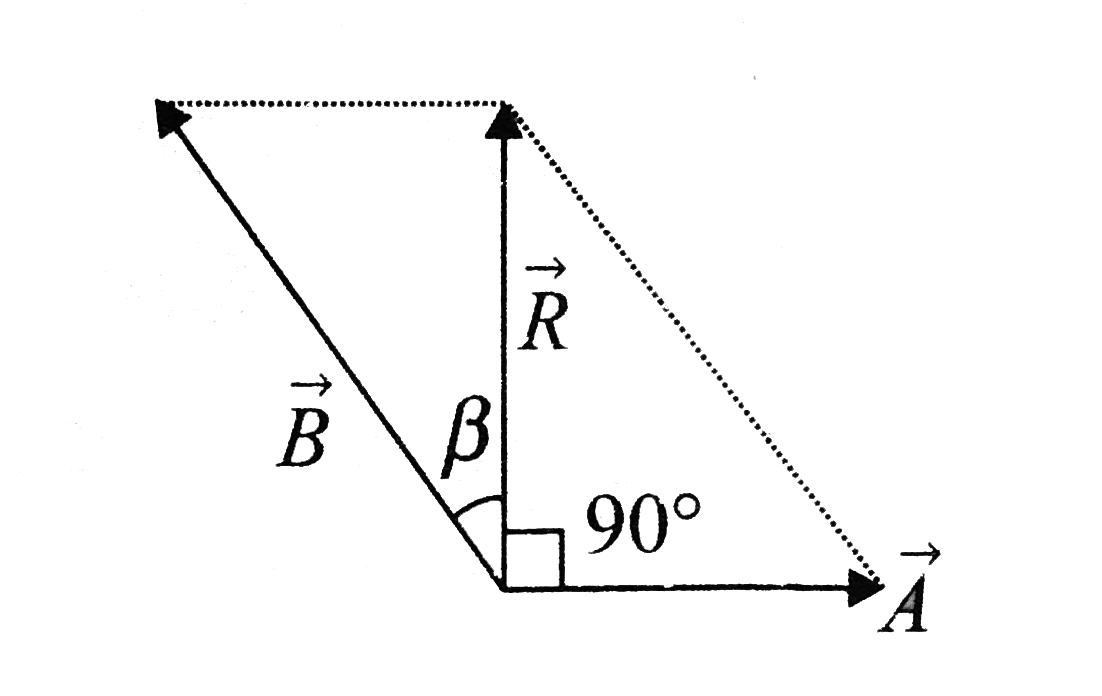The resultant of →a and →b makes α with →a and β with →b, then (a,b represent magnitudes of respective vectors) :
apha<β
α>βifA<B
α<βifA=B
α<βifA<B
The correct Answer is:B
To solve the problem, we need to analyze the relationship between the angles α and β formed by the resultant vector with vectors →a and →b respectively.
1. Understanding the Vectors:
- Let →a and →b be two vectors with magnitudes a and b respectively.
- The resultant vector →R is formed by the vector addition of →a and →b.
2. Angles with the Resultant:
- The angle α is the angle between the resultant vector →R and vector →a.
- The angle β is the angle between the resultant vector →R and vector →b.
3. Relationship Between Angles and Magnitudes:
- The resultant vector is more inclined towards the vector with the greater magnitude. This means that if b>a, the resultant vector →R will be closer to →b than to →a.
- Consequently, the angle β will be smaller than the angle α when b>a. This can be expressed as:
β<αif b>a
4. Analyzing Different Cases:
- Case 1: If a<b, then β<α.
- Case 2: If a=b, then α=β because the resultant will be symmetrically inclined towards both vectors.
- Case 3: If a>b, then α<β.
5. Conclusion:
- From the analysis, we can conclude that the angle α is less than β when b>a and α is greater than β when a>b. Thus, the correct answer is:
- β<α if b>a
- α<β if a>b
- α=β if a=b
Final Answer:
- The correct option is: α<β if a<b.
- Let →a and →b be two vectors with magnitudes a and b respectively.
- The resultant vector →R is formed by the vector addition of →a and →b.
- The angle α is the angle between the resultant vector →R and vector →a.
- The angle β is the angle between the resultant vector →R and vector →b.
- The resultant vector is more inclined towards the vector with the greater magnitude. This means that if b>a, the resultant vector →R will be closer to →b than to →a.
- Consequently, the angle β will be smaller than the angle α when b>a. This can be expressed as:
β<αif b>a
- Case 1: If a<b, then β<α.
- Case 2: If a=b, then α=β because the resultant will be symmetrically inclined towards both vectors.
- Case 3: If a>b, then α<β.
- From the analysis, we can conclude that the angle α is less than β when b>a and α is greater than β when a>b. Thus, the correct answer is:
- β<α if b>a
- α<β if a>b
- α=β if a=b
- The correct option is: α<β if a<b.
Topper's Solved these Questions
Similar Questions
Knowledge Check
- Question 1 - Select One
Two vectors →Aand→B inclined at an angle θ have a resultant →R which makes an angle α with →A. If the directions of →Aand→B are interchanged, the resultant will have the same
AdirectionBmagnitudeCdirection as well as magnitudeDnone of these
If two vectors →aand→b are such that ∣∣→a.→b∣∣=∣∣→a×→b∣∣, then find the angle the vectors →aand→b
View SolutionIf →aand→b are two vectors such that |→a|=2,∣∣→b∣∣=3and→a⋅→b=4 then find the value of ∣∣→a−→b∣∣
View SolutionWhat are the properties fo two vectors →aand→b such that →a+→b=→a−→b ?
View SolutionTwo vectors →Aand→B inclined at an angle θ have a resultant →R which makes an angle α with →A. If the directions of →Aand→B are interchanged, the resultant will have the same
View SolutionIf →a and →b are two vectors such that (→a+→b).→a−→b=0 find the relation between the magnitudes of →a and →b.
View SolutionAnswer the following :
(i) Can 2 similar vectors of different magnitude yield a zero resultant? Can 3 yield?
(ii) Can →a+→b=→a−→b?
(iii) If →a+→b=→c & |→a|+∣∣→b∣∣=|→c|. What further information you can have about these vectors.
(iv) If →a & →b are two non zero vectors such that ∣∣→a+→b∣∣=∣∣→a+→b∣∣, then what is the angle between →a & →b.
(v) Time has a magnitude & direction. Is it a vector?
(iv) When will →a×→b=→a.→b?
(vii) Does the unit vectors →i,→j & →k have units?View SolutionIf →a and →b are two vectors such that ∣∣→a×→b∣∣=→a.→b, then what is the angle between →a and →b.
View Solution


